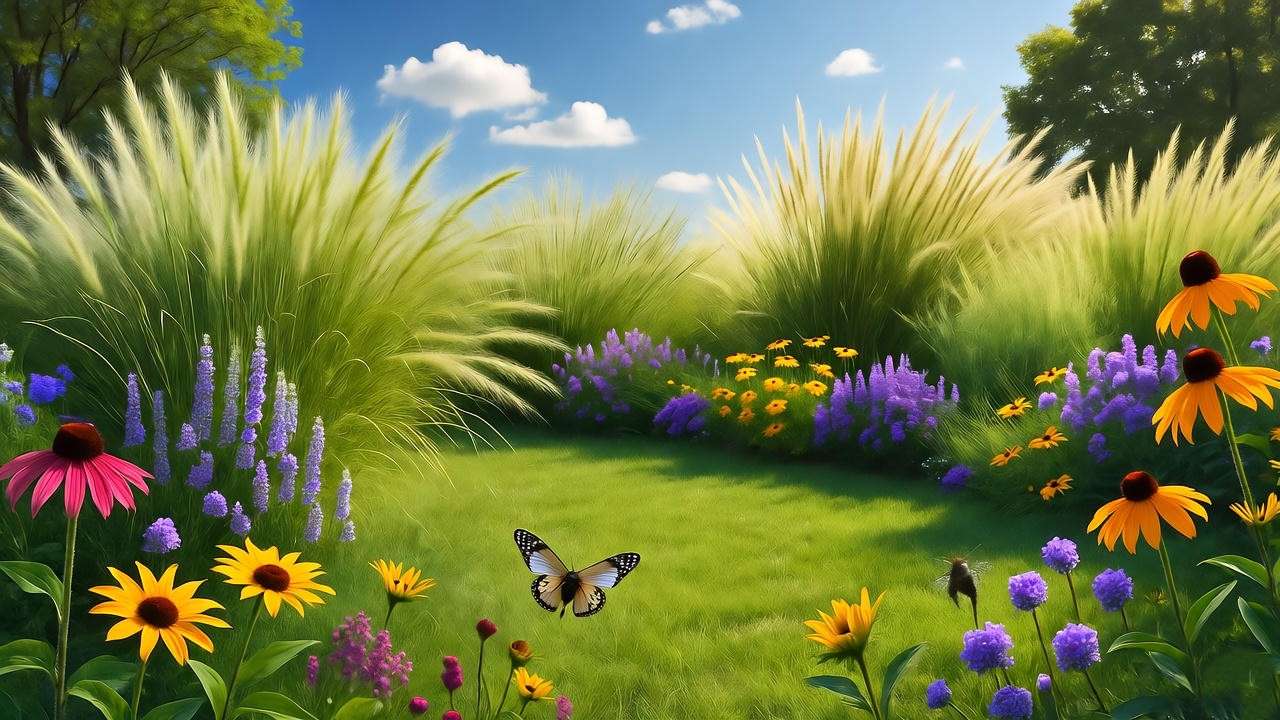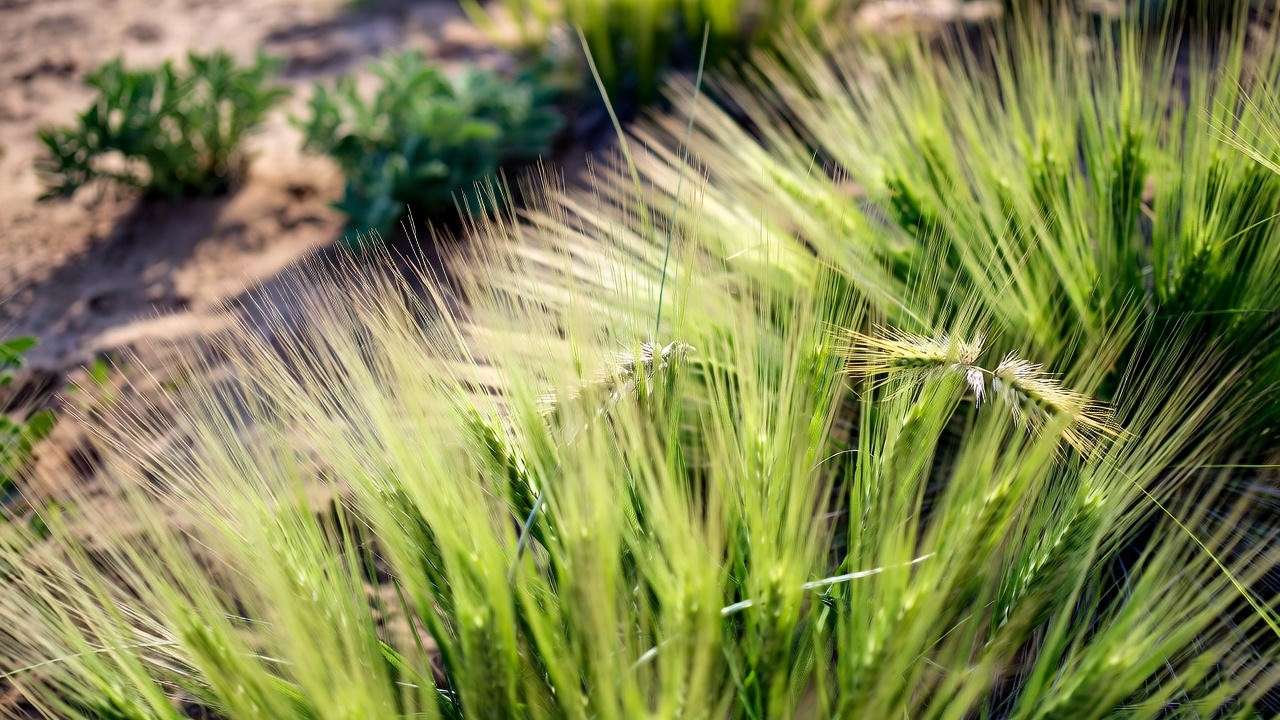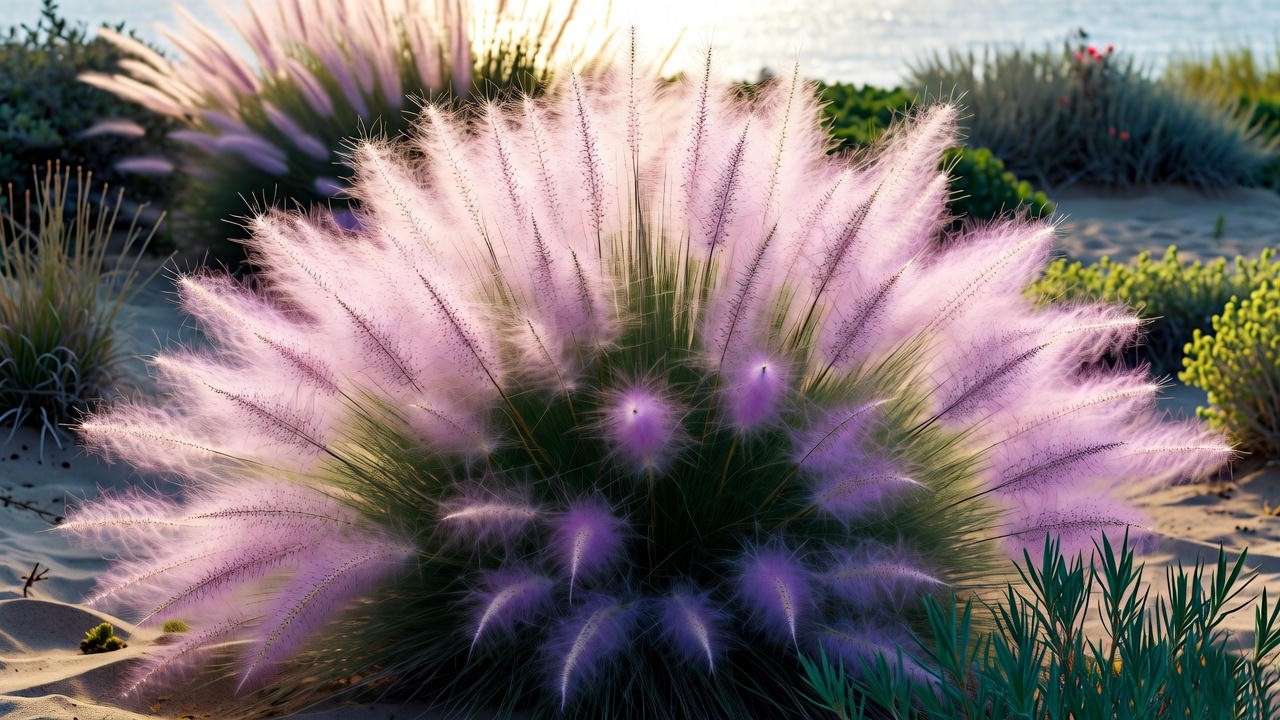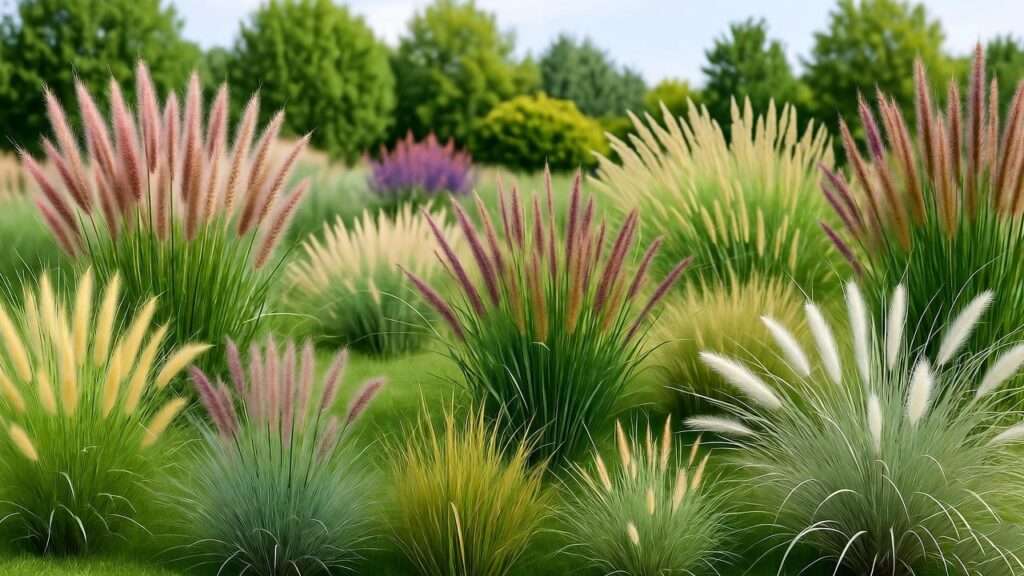Picture a lawn that’s lush, vibrant, and practically takes care of itself — no endless mowing, no sky-high water bills, and a thriving habitat for local wildlife. Sounds like a dream, right? Welcome to the world of native grass plants! These remarkable species, naturally adapted to your region’s climate and soil, are transforming yards into eco-friendly havens. Whether you’re a homeowner aiming to cut maintenance costs or a gardener passionate about sustainability, native grasses offer a low-effort, high-impact solution. In this guide, we’ll explore the top 10 native grass plants that can create a stunning, environmentally conscious lawn while saving you time and resources. Drawing on insights from horticulturists and studies like those from the USDA, we’ll show you why native grasses are the future of landscaping and how to make them work for you. 🌍
What Are Native Grass Plants? 🌾
Defining Native Grasses
Native grass plants are species that have evolved in a specific region over thousands of years, perfectly attuned to local conditions like rainfall, soil, and temperature. Unlike traditional turfgrasses (think Kentucky bluegrass), which often require intensive care, native grasses thrive with minimal intervention. For example, in North America, species like buffalo grass or little bluestem have deep roots in prairie ecosystems, making them ideal for sustainable lawns. Their regional specificity matters — a grass native to the Great Plains may struggle on the humid East Coast, so choosing the right species for your USDA hardiness zone is key.
Why Choose Native Grasses Over Traditional Lawns?
Switching to native grasses offers a trifecta of benefits: environmental, economic, and aesthetic. Environmentally, they conserve water, reduce chemical use, and provide habitats for pollinators like bees and butterflies 🐝. According to the Xerces Society, native grasses can support up to 10 times more insect species than non-native lawns. Economically, they slash maintenance costs — less mowing, watering, and fertilizing means more money in your pocket. Aesthetically, native grasses bring unique textures and colors, from the golden plumes of Indian grass to the delicate seed heads of blue grama, creating a natural, timeless look.
Benefits of Native Grass Plants for Your Lawn 🌞
Environmental Impact
Native grass plants are environmental superstars. Their deep root systems — often extending 6 feet or more — improve soil health by preventing erosion and sequestering carbon. They create thriving ecosystems, offering food and shelter for birds, butterflies, and beneficial insects. A study from the Lady Bird Johnson Wildflower Center found that native grass lawns can increase local biodiversity by up to 30% compared to traditional turf. Plus, their low water needs make them a smart choice in drought-prone areas, aligning with global efforts to combat climate change.

Practical Advantages
From a practical standpoint, native grasses are a gardener’s dream. Most are drought-tolerant, requiring 50-70% less water than traditional lawns, per USDA research. They rarely need fertilizers or pesticides, as they’re naturally resistant to local pests and diseases. Mowing? Often just once or twice a year. This resilience translates to less time spent on upkeep and more time enjoying your yard.
Aesthetic and Functional Versatility
Native grasses aren’t just functional — they’re beautiful. Their varied heights, colors, and textures add depth to any landscape. Use short grasses like buffalo grass for a tidy lawn or tall switchgrass for dramatic privacy screens. Blend them with wildflowers for a prairie-inspired look or plant them in containers for urban spaces. Their versatility makes them perfect for any yard, big or small.
Top 10 Native Grass Plants for a Stunning, Eco-Friendly Lawn 🌻
Here’s our expertly curated list of the top 10 native grass plants, each chosen for its beauty, resilience, and eco-friendly benefits. We’ve included growing tips and ideal conditions to help you select the perfect grasses for your lawn.
1. Buffalo Grass (Bouteloua dactyloides)
- Description: A short, fine-textured grass native to North American prairies, buffalo grass forms a dense, low-growing carpet perfect for minimalist lawns.
- Benefits: Drought-tolerant and requiring mowing only once or twice a year, it’s a low-maintenance champion. It thrives in hot, dry climates and supports local wildlife.
- Growing Tips: Plant in full sun with well-drained soil. Ideal for USDA zones 4-9. Water sparingly once established.
- Fun Fact: Historically, buffalo grass sustained bison herds, earning its name.

2. Blue Grama (Bouteloua gracilis)
- Description: Known for its eyelash-like seed heads, blue grama adds whimsical charm to dry landscapes.
- Benefits: Thrives in poor, sandy soils and requires minimal water. Its seed heads attract birds, enhancing biodiversity.
- Growing Tips: Best in full sun, USDA zones 3-10. Avoid overwatering to prevent root rot.
- Expert Insight: The National Audubon Society recommends blue grama for bird-friendly gardens.
3. Switchgrass (Panicum virgatum)
- Description: A tall, upright grass with airy panicles and vibrant fall colors ranging from red to purple.
- Benefits: Excellent for erosion control and as a habitat for birds. Its height (3-6 feet) makes it ideal for privacy screens.
- Growing Tips: Tolerates wet or dry soils, USDA zones 5-9. Plant in full sun for best results.
- Case Study: A Midwest community used switchgrass to stabilize riverbanks, reducing erosion by 40%.
4. Little Bluestem (Schizachyrium scoparium)
- Description: This grass boasts blue-green foliage that turns fiery red in fall, adding year-round interest.
- Benefits: Low maintenance and pollinator-friendly, it thrives in poor soils and supports butterflies.
- Growing Tips: Ideal for rocky or sandy soils, USDA zones 3-9. Requires full sun.
- Pro Tip: Pair with coneflowers for a stunning native garden combo.
5. Prairie Dropseed (Sporobolus heterolepis)
- Description: A compact, arching grass with fine texture and a sweet, popcorn-like fragrance in late summer.
- Benefits: Perfect for small yards or borders, it’s low-maintenance and attracts pollinators.
- Growing Tips: Prefers well-drained soils and full sun, USDA zones 3-9. Minimal watering needed.
- Aesthetic Appeal: Its delicate mounds create a soft, elegant look.
6. Indian Grass (Sorghastrum nutans)
- Description: Indian grass is a tall, warm-season grass with golden plumes that sway gracefully in the breeze, adding a dramatic flair to any landscape.
- Benefits: Drought-tolerant and highly adaptable, it supports biodiversity by providing seeds for birds and habitat for insects. Its height (4-8 feet) makes it ideal for naturalized areas or backdrops.
- Growing Tips: Thrives in a variety of soils, from clay to sandy, in USDA zones 4-9. Plant in full sun for optimal growth.
- Expert Insight: The Lady Bird Johnson Wildflower Center praises Indian grass for its role in restoring native prairies.
7. Big Bluestem (Andropogon gerardii)
- Description: Known as “turkey foot” for its distinctive three-pronged seed heads, big bluestem is a stately grass with blue-green stems turning reddish in fall.
- Benefits: Its towering height (4-7 feet) makes it perfect for privacy screens or windbreaks. It’s also excellent for erosion control and wildlife habitat.
- Growing Tips: Prefers full sun and tolerates clay or loamy soils, USDA zones 4-9. Minimal maintenance required.
- Case Study: A Kansas restoration project used big bluestem to revive degraded prairie land, boosting local biodiversity.
8. Sideoats Grama (Bouteloua curtipendula)
- Description: This grass features unique oat-like seeds that dangle along one side of its stems, creating a striking visual effect.
- Benefits: Excellent for erosion control and drought-prone areas, it’s also a favorite for pollinators like bees. Its medium height (2-3 feet) suits mixed borders.
- Growing Tips: Plant in full sun with well-drained soil, USDA zones 4-9. Avoid overwatering to maintain health.
- Pro Tip: Combine with wildflowers like black-eyed Susan for a vibrant prairie look.
9. Muhly Grass (Muhlenbergia capillaris)
- Description: Muhly grass steals the show with its airy, pinkish-purple clouds of blooms in fall, creating a dreamy, ethereal effect.
- Benefits: Its ornamental beauty and low water needs make it ideal for warm climates. It’s a magnet for butterflies and adds flair to any garden.
- Growing Tips: Prefers sandy soils and full sun, USDA zones 6-10. Minimal care once established.
- Aesthetic Appeal: Its vibrant fall display is a favorite in coastal and southern gardens.

10. Fountain Grass (Pennisetum alopecuroides)
- Description: With soft, feathery plumes and compact growth, fountain grass adds elegance to small spaces or containers.
- Benefits: Versatile for borders, rock gardens, or urban patios, it’s low-maintenance and drought-tolerant.
- Growing Tips: Plant in full sun with well-drained soil, USDA zones 5-9. Cut back in late winter for fresh spring growth.
- Fun Fact: Its bottlebrush-like plumes are a favorite in floral arrangements.
| Grass | Height | Water Needs | USDA Zones | Best For |
| Buffalo Grass | 4-8 in | Low | 4-9 | Low-maintenance lawns |
| Blue Grama | 1-2 ft | Very Low | 3-10 | Dry, bird-friendly gardens |
| Switchgrass | 3-6 ft | Low-Moderate | 5-9 | Privacy screens, erosion control |
| Little Bluestem | 2-4 ft | Low | 3-9 | Pollinator gardens |
| Prairie Dropseed | 1-3 ft | Low | 3-9 | Small yards, borders |
| Indian Grass | 4-8 ft | Low | 4-9 | Naturalized areas, backdrops |
| Big Bluestem | 4-7 ft | Low | 4-9 | Windbreaks, erosion control |
| Sideoats Grama | 2-3 ft | Low | 4-9 | Mixed borders, erosion control |
| Muhly Grass | 2-4 ft | Low | 6-10 | Ornamental, warm climates |
| Fountain Grass | 2-4 ft | Low | 5-9 | Containers, urban spaces |
How to Incorporate Native Grasses Into Your Landscape Design 🏡
Planning Your Native Grass Lawn
Creating a native grass lawn starts with understanding your yard’s conditions. Test your soil type (sandy, clay, or loamy) and assess sunlight exposure — most native grasses thrive in full sun. Check your USDA hardiness zone to select species suited to your climate. For example, muhly grass excels in warmer zones (6-10), while blue grama adapts to colder regions (3-10). Consult resources like your local native plant society or the USDA Plant Database for region-specific recommendations. Planning ensures your lawn is both beautiful and sustainable.
Design Ideas for Every Yard
Native grasses are incredibly versatile. For a full lawn replacement, use low-growing species like buffalo grass or blue grama for a tidy, low-maintenance look. For a wild, prairie-inspired aesthetic, mix tall grasses like switchgrass with native wildflowers such as coneflowers or asters. Short on space? Plant prairie dropseed or fountain grass in containers or borders for a pop of texture. Grasses can also line pathways or create natural privacy screens, blending functionality with beauty.
Installation Tips
Start by clearing your yard of non-native turf and invasive weeds, using organic methods like smothering with cardboard or manual removal. Depending on your budget, plant native grasses via seeds, plugs, or sod — seeds are cost-effective but slower, while plugs establish faster. Water regularly during the first year to help roots establish, then reduce to minimal irrigation. Mulch with organic material to suppress weeds and retain moisture. The Xerces Society recommends planting in spring or fall for best results.

Caring for Your Native Grass Lawn: Maintenance Made Easy 🛠️
Watering and Fertilizing
Once established, native grasses need little water, often thriving on rainfall alone. For example, buffalo grass and blue grama can survive with as little as 10 inches of annual precipitation. During the first year, water weekly to support root growth, then taper off. Avoid chemical fertilizers, which can harm native ecosystems. Instead, use compost or organic amendments sparingly to boost soil health, as recommended by university extension programs.
Mowing and Seasonal Care
Unlike traditional lawns, native grasses require minimal mowing — often just once a year in late winter to refresh growth. For taller grasses like big bluestem, leave seed heads through winter to provide wildlife habitat. In spring, clear debris and cut back dead foliage. Collect seeds from grasses like Indian grass to propagate or share with local conservation groups, enhancing community biodiversity efforts.
Pest and Weed Management
Native grasses are naturally resistant to local pests and diseases, reducing the need for pesticides. To manage weeds, hand-pull invasives or use mulch to smother them. Companion planting with native wildflowers can also crowd out weeds naturally. The National Wildlife Federation suggests regular monitoring to catch invasives early, ensuring your lawn stays healthy and eco-friendly.
Common Challenges and Solutions When Growing Native Grasses ⚠️
Overcoming Slow Establishment
Native grasses often take 1-2 years to fully establish due to their deep root systems, which prioritize long-term resilience over quick growth. To speed up the process, prepare soil thoroughly by removing competing plants and adding organic matter. Water consistently during the first season, and be patient — the wait pays off with a durable, low-maintenance lawn. Extension services like those from Cornell University emphasize proper soil prep for success.
Dealing with Competition from Non-Native Species
Invasive plants like crabgrass or Bermuda grass can challenge native lawns. Remove them before planting using organic methods like solarization (covering soil with plastic to kill weeds with heat). After planting, mulch heavily and monitor for regrowth. Pairing grasses with competitive natives like wildflowers can further suppress invasives, creating a balanced ecosystem.
Addressing Aesthetic Concerns
Some worry native grass lawns look “messy” compared to manicured turf. Educate yourself and others about their natural beauty and ecological benefits. For a tidier look, choose shorter grasses like buffalo grass or mow taller species occasionally. If facing HOA resistance, share data on water savings and biodiversity benefits — many HOAs now embrace native landscaping with proper documentation.
FAQs About Native Grass Plants ❓
- Are native grass lawns safe for pets and kids? Yes, native grasses are non-toxic and safe. Their durability withstands rough play, and they require no harmful chemicals.
- How much water do native grasses really save? Studies show native grasses use 50-70% less water than traditional lawns, saving thousands of gallons annually.
- Can I grow native grasses in shaded areas? Most prefer full sun, but species like prairie dropseed tolerate partial shade. Check your yard’s light conditions.
- How do I convince my HOA to allow a native grass lawn? Present research on environmental and cost benefits, and propose a neat design with low-growing grasses.
- What’s the cost of converting to a native grass lawn? Costs vary ($1-$5 per square foot for plugs or sod), but long-term savings on water and maintenance are significant.
Conclusion: Transform Your Lawn with Native Grasses 🌟
Native grass plants offer a win-win for homeowners and the planet: a gorgeous, low-maintenance lawn that saves water, supports wildlife, and reduces costs. From the delicate plumes of muhly grass to the sturdy elegance of big bluestem, these 10 species prove sustainability can be stunning. Start small — try a patch of buffalo grass or a border of prairie dropseed — and consult your local nursery or native plant society for tailored advice. Join the growing movement of eco-conscious gardeners and transform your yard into a thriving, sustainable ecosystem. Your lawn, your wallet, and the environment will thank you! 🌱














